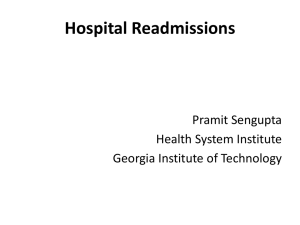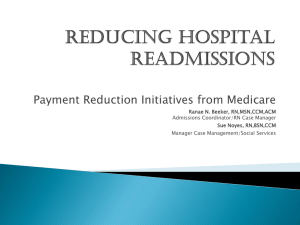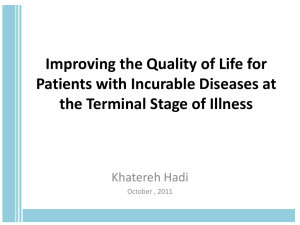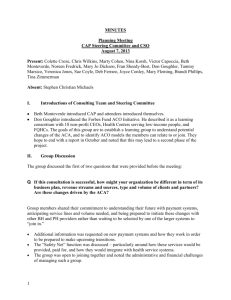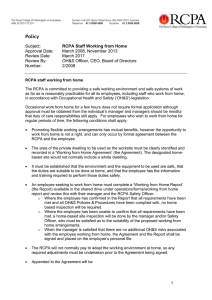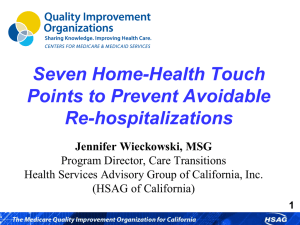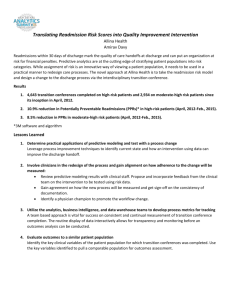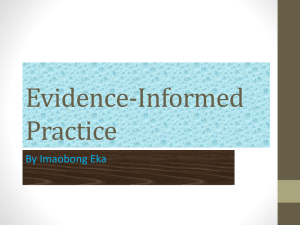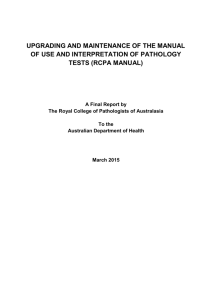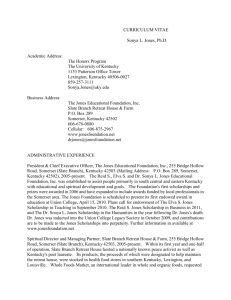5-9-2014 CAPMinutes... - Conference of Allegheny Providers
advertisement
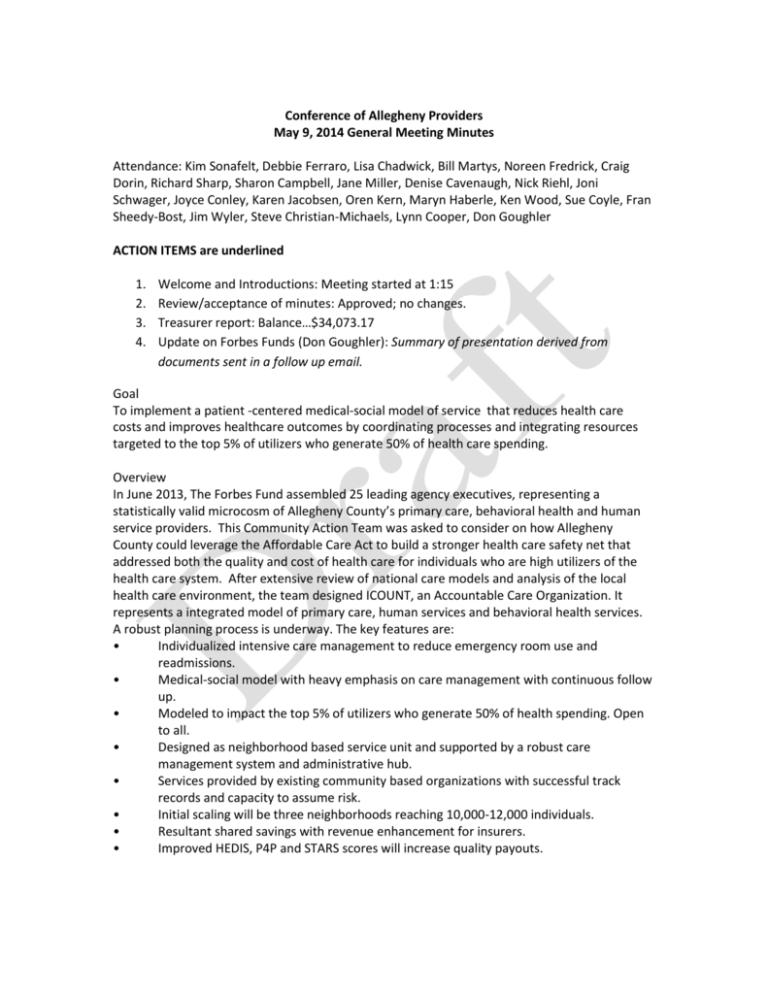
Conference of Allegheny Providers May 9, 2014 General Meeting Minutes Attendance: Kim Sonafelt, Debbie Ferraro, Lisa Chadwick, Bill Martys, Noreen Fredrick, Craig Dorin, Richard Sharp, Sharon Campbell, Jane Miller, Denise Cavenaugh, Nick Riehl, Joni Schwager, Joyce Conley, Karen Jacobsen, Oren Kern, Maryn Haberle, Ken Wood, Sue Coyle, Fran Sheedy-Bost, Jim Wyler, Steve Christian-Michaels, Lynn Cooper, Don Goughler ACTION ITEMS are underlined 1. 2. 3. 4. Welcome and Introductions: Meeting started at 1:15 Review/acceptance of minutes: Approved; no changes. Treasurer report: Balance…$34,073.17 Update on Forbes Funds (Don Goughler): Summary of presentation derived from documents sent in a follow up email. Goal To implement a patient -centered medical-social model of service that reduces health care costs and improves healthcare outcomes by coordinating processes and integrating resources targeted to the top 5% of utilizers who generate 50% of health care spending. Overview In June 2013, The Forbes Fund assembled 25 leading agency executives, representing a statistically valid microcosm of Allegheny County’s primary care, behavioral health and human service providers. This Community Action Team was asked to consider on how Allegheny County could leverage the Affordable Care Act to build a stronger health care safety net that addressed both the quality and cost of health care for individuals who are high utilizers of the health care system. After extensive review of national care models and analysis of the local health care environment, the team designed ICOUNT, an Accountable Care Organization. It represents a integrated model of primary care, human services and behavioral health services. A robust planning process is underway. The key features are: • Individualized intensive care management to reduce emergency room use and readmissions. • Medical-social model with heavy emphasis on care management with continuous follow up. • Modeled to impact the top 5% of utilizers who generate 50% of health spending. Open to all. • Designed as neighborhood based service unit and supported by a robust care management system and administrative hub. • Services provided by existing community based organizations with successful track records and capacity to assume risk. • Initial scaling will be three neighborhoods reaching 10,000-12,000 individuals. • Resultant shared savings with revenue enhancement for insurers. • Improved HEDIS, P4P and STARS scores will increase quality payouts. Strategy I-Count will establish 3 community based service units supported by one administrative hub. Each unit will be comprised of a primary care providers-Federally Qualified Health Center and/or larger primary care practices, and approximately 15 social service agency clusters with expertise in population management. The project focuses on the individual patient, and intends to improve the individual’s experience and treatment results. The strategy is comprehensive, not exclusive, and does not displace services that exist at the present time but provides stronger linkages among them resulting in a smoother patient pathway. The intent is to achieve more efficient transition from acute care hospitals, focusing on reducing inappropriate admissions and readmissions and improving HEDIS and STARS preventive health delivery and scores for a chronically ill at-risk population in Allegheny County. Care Planning and Management The health management focus will center on five diagnostic areas: CHF, COPD, serious and persistent behavioral health issues, complications of renal disease and diabetes. Prior to discharge, I COUNT will assess patients and rank order their scores according to six life dimensions and will arrange clusters of service with intense care management to create a treatment plan and assure that plan is carried out. The care team will follow the patient in the home setting every day, using both home visits and telephone contacts, with reports back to treating clinicians and insurers. Service Impact Many admissions to emergency rooms and readmissions are tied to the social determinants of the disease and costs such as social isolation, need for emergency shelter, utilities, and critical transportation for life’s essentials. I COUNT will address these challenges in a manner that resolves them through a comprehensive care approach. Services in the home and through community social service resources will be integrated in a collaborative and holistic treatment plan, overcoming confusion and disorganization in the care process and emphasizing ongoing attention to the individual patient, with emphasis on the weeks directly following discharge when the threat of readmission is most prominent. This model will bridge historical barriers impeding the coordination of medical, behavioral and social care. Services in the home will be coordinated in the proper sequence and provided in a timely manner in accordance with discharge instructions. I COUNT will provide robust clinical and community based solutions, care planning and coordination, medical management of comorbid conditions, ongoing pharmaceutical oversight as well as caregiver and primary care physician supports. I COUNT will differentiate itself with daily contact, on-site visits and extensive use of social and medical services in an integrated design. As a result, service will be more easily accessible, timely, coordinated and meaningfully focused on a range of presenting issues. Financial Impact Great emphasis will be placed on identifying and closing gaps in preventative care to improve HEDIS, P4P, and STARS ratings and increase the quality payouts to the insurer. A 4 to 1 return on investment is anticipated based on evaluation of current costs of admission, readmission, and emergency care when compared to in-community treatment alternatives. I COUNT will also present an opportunity to legitimately improve the Medicare Advantage and Special Needs Plans, leading to another revenue improvement for the insurer. I COUNT will focus on the ten greatest reasons for readmission and the gaps in preventive care. Each readmission that can be prevented saves $7700 and each emergency room visit diverted to an appropriate primary care alternative saves $600. More than $60 million could potentially be saved and I COUNT will want a fairly small portion of the savings after year 1. Funding The planning process is being spearheaded by The Forbes Funds- a supporting organization of The Pittsburgh Foundation. Funding is being provided by Jewish Healthcare Foundation, McCune Foundation, Heinz Endowments, Hillman Foundation, Pittsburgh Foundation, United Way, BNYMellon, Fine Foundation, and Staunton Farm Foundation. It is our hope that the initial implementation will be underwritten by an Innovations SIMS Grant from the Center for Medicare and Medicaid Services administered by the Pennsylvania Department of Health. I COUNT will transition to more of a shared savings/revenue improvement model in the second and third years. Follow up questions, comments and suggestions: Which models should be explored? Hennepin County MN. Massachusetts and New Jersey. Geissinger also which has a nurse driven model. How does role of local DHS fit? They are briefed. Not against, sort of standing by sideline watching not sure effort will work. Claims data and usage rates are being examined to make determinations. State puts money into proposal for care coordination. State requesting 26mil. If done locally An information request seeking interest will be sent to providers in the next 2-3 weeks. State will seek RFPs and then come up with a statewide model. This will be a competitive process. 5. Subcommittee reports: a. ID – Karen Jacobsen i. Celebration of success. 14 agencies participated. ii. PROMISE Applications: 1. OMAP said applications were down to 5-6 weeks but now back up to 14 weeks. Problem with people waiting for services. Will take this issue to TPA to address. There will also no longer be back dating per ODP bulletin. iii. Goodwill and 5 other agencies were informed that a specific Wcode for senior program is wrong and have 30 days to determine how to correct and continue services. Transportation is at issue. Talk to Ed and ask Michelle O’Toole to have a meeting to address. Trying to get this overturned. Need to discuss broader application. iv. Home and Community Habilitation: Discussed how agencies are reimbursing staff and general operations. v. Considering holding a Direct Service Provider (DSP) panel discussion to educate public on importance of this essential service. vi. Talked about medication trainings and meeting requirements – time and resources needed. vii. Financial audits: County fiscal staff are doing room and board audits that are actually being conducted as full complete independent audits. (Getting into bylaws, inventory, financial practices, etc. Oren said for county funded programs they will be doing regular claims validation. viii. ODP is looking at one person homes as restrictive. ODP does not see these as least restrictive. b. BH – Ken Wood: i. NEW Draft Authorization to release information form: Give feedback to Steve by 6/1. Not looking at kids at the moment because of level and degree of complications. Form is designed for integrated care center environment. ii. PROMISE is saying it has been delayed – no date given… now one knows what this means. Hoping RCPA will make sure this is not a piece meal implementation. 1. Discussed this issue with Dennis Marion. 2. Has to be consistency among all payers. 3. Will discuss this with the insurance commission as well. Insurance commission is overwhelmed at this time. 4. Lynn will call Allison Beam to get some information on this. iii. Sue to be a representative on AHCI board. Community Care has been working with Out Patient (OP) providers on process improvement. If done would there be eligibility for a bonus. Community Care is required to do this. AHCI said providers should give Community Care feedback on other areas for bonus. Sue will talk with AHCI about the ideas below. Concern about consistency of outcomes and no real incentive for stretch goals. Really look at things we are all doing already focus on quality and value. [CCBH only MCO that has not passed on financial savings as increases to providers.] Sue will talk with Brandi about this as well. 1. Identify some measure/goal for children 2. Service coordination; tracking physical health, SPA meeting effectiveness 3. Partial measure/goal iv. Discussed – recent document about documentation by peer specialist not being billable! Not sure if this is applied to PROMISE and Healthchoices as well. Author of document is to attend RCPA MH (6/4) committee meeting to address this. v. Discussion: Value Behavioral Health has done an audit on OP therapy looking at CPT codes – said do not meet criteria because special requirements were not met, they could not explain what the special requirements were that were not met. 1. White paper written really made this issue get attention, traction and move to resolution. 2. Val Vacari – really helped to make O/P regulations move forward. Along with Psychiatric Society who pushed. Community Care also helped with making rates that would work. 3. Lynn Cooper encourages submission of waivers immediately for things that are not needed or not working. 4. Time frames have been improved. vi. E & M (Evaluation and Management) Codes work – Physician compensation guidelines. Time is an element being emphasized. RCPA is helping to address this issue. Eg. MCOs are only paying for 3 levels when there are many that could be used and be reflective of service provided. This raises a compliance issue on both the side of insurance and providers. c. Children’s – Richard Sharp i. Childline: Reporting still seeking update on what county will do for training. Walter Smith not doing any training at this time. Probably do something in the fall once things are finalized. ii. Don Clark is asking for feedback on teaming and conferencing. Judges are also asking about the use of these approaches. iii. BHRS redesign issues: 1. Jessica Carlton – shared finding. Only one North East county; Lackawanna showed an increase. 3 families have a civil suit against Community Care for service denial. Infringement of civil rights. 2. Bulletin coming out with emphasis on parental involvement – restatement of position. iv. RCPA important meeting (Tues) meeting with State and some MCOs to discuss STAP reduction, effect of BH specialist licensing on access to services for kids with autism. This in response to providers and families saying they are having problems despite state saying all is ok. [STAP reduction is being portrayed as the providers’ fault.] v. CHILD CAP AHCI ACA discussion: seeking 2 ideas to show system effectiveness. Possible ideas. School related – attendance, parent confidence scale, admission/readmission to hospital, medical consumption of services (service increase/decrease), suicide impact. vi. Nomination for replacement of co chair. Kate Pompa of Wesley Spectrum. Sharon Campbell will remain a co chair. vii. SAP, suicide – increasing training for suicide prevention. Universal BH screening. See notes of picture. viii. Georgianne P. is retiring. 5/16 last day. d. Compliance (Craig): Conference Results i. Goal of 60 attendees not met for days 1 & 2. 45 attendees for 2-day portion of conference and 19 participants for 3-day investigation training. ii. Raised $17,280 through registration and $33k from AHCI and CAP for a total of $50,280. Roughly $10k shy of budget. iii. Attorneys aware of our shortfall agreed to only take the balance of the remainder after expenses. Current outstanding costs are with Holy Family for facilities and food; travel costs. iv. The training received excellent feedback from participants. 6. Additional reports a. ACA work group updates: i. Met with Brandi Phillips. Discussed survey results and tried to determine why participation dwindled from 60 -19. ii. Question raised about how to encourage participation and get better board education and engagement. iii. Talked about children providers and how to include them. Integration. iv. More focused discussion on mergers and acquisitions. v. Consultation on different type of screening tools. vi. How to get started on outcomes data particularly that which is already available. vii. Integrated care outcome measures. viii. Training on change management. b. Steve Christian Michaels: i. CANS/ANSA Privacy concerns (handout provided) – Steve needs feedback from members by next meeting. Steve has not heard any . Deb added that consumers have raised concerns about particular pieces of information not being shared with certain parties. This has renewed discussion and exploration of these guidelines. ii. BDAP review yielded a heightened focus on confidentiality. Questions about release forms and language used. This is expected to be a trend moving forward. c. Jane Miller – Legislative activities. i. Ask everyone to get out the vote. Last day for absentee ballots is the 15th. ii. Wolf and McCord are still front runners. iii. Ferlo will be lost because of redistricting. Vulakovich is going to take over. He is interested in our needs but not agreeable to our requests. His aide is sympathetic to our causes so we need to work through her. iv. [Jane wants us a fuss with a tiara at her retirement!] June meeting (6/13) at 1pm is the last meeting until September. Respectfully submitted: Craig Dorin
